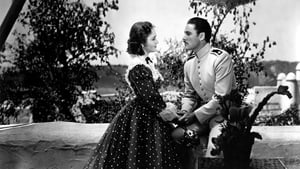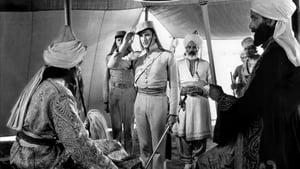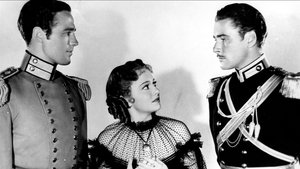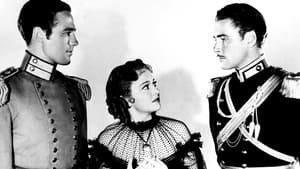Contact: info@alwanfilm.com
Video Sources 0 Views

Synopsis
The Charge of the Light Brigade 1936 Colorized Review: A Swashbuckling War Epic in Early Color

Introduction
“The Charge of the Light Brigade” (1936) is a cinematic gem that combines adventure, romance, and historical drama to recreate one of the most famous—and tragic—military events in history. Starring the iconic Errol Flynn and Olivia de Havilland, and directed by Michael Curtiz, this swashbuckling epic was made during the golden age of Hollywood. Though originally released in black and white, the film was later colorized, adding a layer of visual splendor to its already stunning production values.
In this article, we will explore the impact of the early colorized version of “The Charge of the Light Brigade” on the viewing experience, analyze its contributions to film history, and discuss its place within the war and adventure genres. We’ll also examine the performances, directorial vision, and the ongoing debate about the colorization of classic films.
Check The Full Colorized Movies List
Check Our Colorized Movies Trailer Channel
Understanding The Charge of the Light Brigade 1936 Colorized: Director, Cast, and Genre
Directed by Michael Curtiz, “The Charge of the Light Brigade” is a hallmark of 1930s Hollywood. Curtiz, who would later go on to direct the classic “Casablanca” (1942), was known for his ability to blend large-scale action sequences with intimate character moments. His vision for “The Charge of the Light Brigade” was to create a stirring, heroic narrative centered on the bravery and gallantry of British soldiers during the Crimean War. Though the film takes substantial liberties with historical facts, it stands as a testament to Hollywood’s ability to dramatize history for mass appeal.
At the heart of the film is Errol Flynn, who plays Major Geoffrey Vickers, the film’s fictionalized hero. Flynn, known for his dashing looks and swashbuckling charisma, was one of the biggest stars of the 1930s, and his performance in this film is no exception. He brings both action and depth to the role, making Vickers a compelling, if romanticized, figure.
Opposite Flynn is Olivia de Havilland, playing Elsa Campbell, Vickers’ love interest. De Havilland, who frequently co-starred with Flynn, brings grace and emotional weight to the film. Their on-screen chemistry, previously established in films like “Captain Blood” (1935), is electric, adding a romantic subplot to the film’s war-driven narrative.
The film is categorized as a war adventure, blending the swashbuckling action of Flynn’s earlier films with the dramatic intensity of war movies. While it is primarily remembered for its climactic charge sequence, the film also delves into themes of honor, duty, and sacrifice, all framed within the larger context of British imperialism.
Exploring the World of The Charge of the Light Brigade 1936 Colorized: Plot and Characters
“The Charge of the Light Brigade” is set during the Crimean War, specifically focusing on the events that led to the infamous cavalry charge during the Battle of Balaclava in 1854. The film, however, significantly deviates from historical events, introducing a fictional narrative involving personal vendettas, love triangles, and political intrigue.
Major Geoffrey Vickers (Errol Flynn) is a British cavalry officer stationed in India, where he and his brother, Captain Perry Vickers (Patric Knowles), serve under the command of Sir Charles Macefield. Geoffrey is engaged to Elsa Campbell (Olivia de Havilland), but tensions arise when Perry also falls in love with Elsa, creating a love triangle that adds emotional depth to the story.
The main antagonist is Surat Khan (played by C. Henry Gordon), a ruthless Indian ruler who betrays the British and massacres civilians in the fictional town of Chukoti, sparking a personal vendetta for Vickers. This fictionalized subplot is one of the film’s significant departures from historical accuracy but serves as a narrative device that propels Vickers into the final climactic charge against the Russians at Balaclava.
The film culminates in the famous “Charge of the Light Brigade,” where the British cavalry, under mistaken orders, launches a heroic but doomed assault against heavily fortified Russian artillery. This scene, which remains one of the most famous battle sequences in early Hollywood cinema, is both thrilling and tragic, capturing the gallantry and futility of the event.
The Art of Film Colorization
The process of film colorization involves digitally adding color to black-and-white films, transforming the viewing experience for modern audiences. In the case of “The Charge of the Light Brigade,” the colorization process brought new life to the film’s already impressive visual storytelling. However, as with most early colorized films, the process was met with mixed reactions, especially from film purists who argued that the addition of color altered the film’s original artistic vision.
Colorization typically involves the careful application of colors to each frame, often using historical references or educated guesses to ensure the hues are as accurate as possible. While some scenes in “The Charge of the Light Brigade” benefited from this enhancement—particularly the sweeping landscapes and elaborate costumes—others lost some of the dramatic shadows and contrasts that black-and-white cinematography excels at.
Early Colored Films: A Brief History
The history of color in cinema dates back to the early 20th century, with filmmakers experimenting with various techniques to add color to black-and-white films. Early methods involved hand-painting frames or using stencils to apply color, but these methods were time-consuming and expensive. It wasn’t until the development of Technicolor in the 1930s that full-color films became a viable option for major studios.
Technicolor revolutionized the film industry, offering rich, vibrant hues that brought a new dimension to movies like “The Wizard of Oz” (1939) and “Gone with the Wind” (1939). However, because of its cost, many studios continued to produce films in black and white. It wasn’t until decades later, with the advent of home video and color television, that studios began revisiting their black-and-white classics with the intention of colorizing them for modern audiences.
“The Charge of the Light Brigade” and Its Early Colored Version
When “The Charge of the Light Brigade” was colorized, it gave audiences a chance to experience the film in a new way, with vibrant hues replacing the stark contrasts of the original black-and-white version. The colorized version enhanced the film’s visual appeal, particularly during the grand battle sequences, where the bright red of British uniforms and the earth tones of the battlefield create a striking image.
The decision to colorize the film was partly driven by the desire to make older films more appealing to modern audiences. With color television becoming the standard by the 1980s, colorized versions of classic films were seen as a way to capitalize on nostalgia while also introducing these films to a new generation. However, this decision also sparked debate about the artistic integrity of such alterations, as many felt that the colorization process altered the film’s original aesthetic.
The Debate Over Film Colorization
Film colorization has long been a controversial topic in the world of cinema. While some argue that it makes classic films more accessible to modern audiences, others believe it detracts from the artistic vision of the original filmmakers. Critics of colorization often point to the fact that black-and-white cinematography was a deliberate choice for many filmmakers, who used the medium to create specific moods and atmospheres.
In the case of “The Charge of the Light Brigade,” the original black-and-white version is notable for its dramatic use of light and shadow, particularly during the intense battle scenes. The stark contrast between light and dark helped convey the chaos and violence of war. The colorized version, while visually striking, loses some of this impact, as the added color softens the sharpness of the original cinematography.
Examining “The Charge of the Light Brigade” as an Early Colored Film
As one of the early films to receive the colorization treatment, “The Charge of the Light Brigade” provides an interesting case study in how the addition of color can enhance or detract from a film’s original impact. The epic battle scenes, in particular, benefit from the colorization, as the bright uniforms and smoky battlefield create a more immersive experience for viewers.
However, the colorization also alters the mood of certain scenes. The romantic subplot between Vickers and Elsa, for example, is visually softer in black and white, with the use of shadows and lighting creating a more intimate atmosphere. In color, the emotional depth of these scenes is somewhat diminished, as the focus shifts from the characters to the more vibrant backgrounds and costumes.
Influence and Legacy: The Charge of the Light Brigade 1936 Colorized’s Impact on Cinema
“The Charge of the Light Brigade” has had a lasting impact on the war and adventure genres, influencing countless films that followed. Its depiction of heroism, sacrifice, and military gallantry set a standard for future war epics, and its large-scale battle scenes laid the groundwork for the action sequences that would become a hallmark of Hollywood filmmaking.
Moreover, Errol Flynn’s performance as Geoffrey Vickers helped solidify his status as one of the greatest swashbuckling heroes of the silver screen. His portrayal of Vickers as a man torn between duty and personal loyalty resonates with audiences even today, and his charismatic presence in the film continues to influence the way Hollywood portrays action heroes.
The film also contributed to the popularity of historical epics in the 1930s and 1940s. Along with films like “The Adventures of Robin Hood” (1938) and “Captain Blood” (1935), “The Charge of the Light Brigade” helped define the swashbuckling adventure genre, blending historical fiction with romance, action, and spectacle.
Director’s Cinematic Legacy: Beyond The Charge of the Light Brigade 1936 Colorized
Michael Curtiz, the director of “The Charge of the Light Brigade,” was one of Hollywood’s most versatile and prolific filmmakers. Known for his ability to work across genres, Curtiz directed everything from musicals to film noir to historical epics. His work on “The Charge of the Light Brigade” showcases his talent for large-scale action and character-driven storytelling, a combination that would later be perfected in films like “Casablanca.”
Curtiz’s influence can be seen in the way future directors approached war films, blending epic battle sequences with personal drama to create emotionally resonant stories. His ability to draw compelling performances from his actors—particularly Flynn—was a key factor in his success, and his films continue to be studied and admired by filmmakers around the world.
Themes Explored in The Charge of the Light Brigade 1936 Colorized
“The Charge of the Light Brigade” explores several themes that resonate with audiences to this day. The film delves into the concept of duty, as Geoffrey Vickers is driven by a sense of loyalty to his country and his fellow soldiers. His decision to lead the charge, despite knowing it is a suicide mission, is a testament to his commitment to his comrades.
The film also touches on themes of honor and sacrifice. The Light Brigade’s charge, though ultimately futile, is portrayed as a heroic act of selflessness, with each soldier willing to die for the greater good. This theme of sacrifice is further complicated by the love triangle between Vickers, his brother, and Elsa, adding an emotional layer to the story.
Finally, the film examines the futility of war, as the climactic charge ends in tragedy. Despite their bravery, the soldiers of the Light Brigade are ultimately defeated, highlighting the senselessness of the conflict.
Reception and Controversy Surrounding The Charge of the Light Brigade 1936 Colorized
Upon its release, “The Charge of the Light Brigade” was met with both praise and criticism. While many audiences and critics were captivated by the film’s thrilling action sequences and Flynn’s charismatic performance, others took issue with its historical inaccuracies. The film’s portrayal of the Crimean War, particularly the fictional massacre at Chukoti, was seen as a dramatic embellishment of real events.
The colorized version of the film, released decades later, sparked further controversy. Film purists argued that the addition of color detracted from the film’s original artistic vision, while others appreciated the enhanced visual experience.
Where to Watch The Charge of the Light Brigade 1936 Colorized Online
Today, “The Charge of the Light Brigade” is available on several streaming platforms, making it accessible to both new audiences and longtime fans. Platforms like Amazon Prime, HBO Max, and Apple TV offer the film in its original black-and-white version, while the colorized version is available on DVD and Blu-ray.
FAQs About The Charge of the Light Brigade 1936 Colorized
Q: Is “The Charge of the Light Brigade” historically accurate?
A: While the film is based on real events, it takes significant liberties with history, particularly in its portrayal of the lead-up to the famous charge.
Q: Why was the film colorized?
A: The film was colorized to attract new audiences and offer a fresh perspective on the classic story, though the original black-and-white version is still widely available.
Q: Where was “The Charge of the Light Brigade” filmed?
A: The film was primarily shot in California, with several outdoor scenes filmed on location to capture the expansive landscapes.
Conclusion
“The Charge of the Light Brigade” (1936) remains a classic in the adventure and war film genres, thanks to its epic scale, compelling performances, and thrilling battle sequences. Whether viewed in its original black-and-white format or its later colorized version, the film continues to captivate audiences with its blend of romance, action, and historical drama.
While the debate over film colorization will likely continue, there’s no denying the enduring legacy of “The Charge of the Light Brigade.” For fans of classic cinema and swashbuckling adventure, this film is a must-watch—preferably in its original format to fully appreciate Michael Curtiz’s directorial vision and Errol Flynn’s unforgettable performance.














